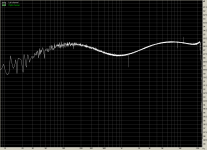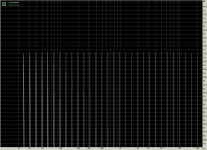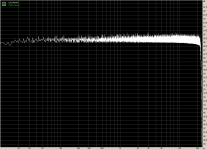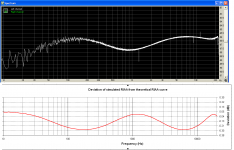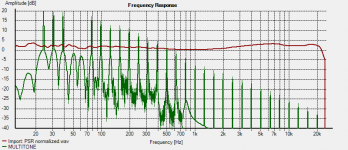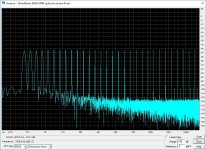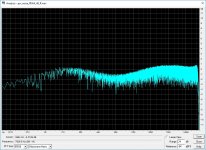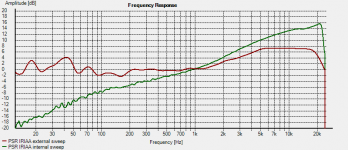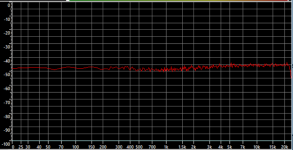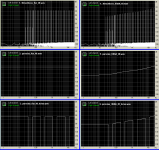Would the EQ code run in the DSP or as a userspace application?
IME a bi-quad or two should be OK and are already built into SoX. Not sure about all of it. IMO a click detection algorithm has little benefit from being done at double precision math but I don't have any recent experience with these processors. At 96k there are literally 1000's of CPU cycles between samples (in my simple way of looking at it). I suppose I could bite the bullet and look into the Ladspa route then no need for DSP.
At 96k how many effects can SoX run before it chokes?
Last edited:
Looks perfect,
In sim yes 🙂
Zooming-in at the FFT :

Scott
This is the FFT from MiniDSP out when it is fed with the 30multitone_IRIAA_48 (att.1) and the psrnoise_IRIAA_48 (att.2).
The results are the same with either the RIAA biquad coefficients that you give on Table 1a of the LA article for gain of 13,16dB@1kHz
[a0:1, a1:1.73273489, a2:-0.73451925] [b0:1, b1:-0.75549731, b2:-0.16463057]
or these that I have used for gain of 0dB@1kHz
[a0:1, a1:1.73273489, a2:-0.73451925] [b0:0.219743778, b1: -0.166015833272721, b2:-0.036176543448862]
When I disable the RIAA equalisation, i.e. in flat configuration, the output of the MiniDSP is ruler flat when it is fed with 30multitone_flat_48 (att.3) or psrnoise_flat_48 (att.4).
I have varied the input level with no change. I even used another pc (of course, no change again)
Scott, when you have the time and you are in the mood, please check with your miniDSP if you get the same waviness with the RIAA implementation.🙂
George
Attachments
George, can you post the recorded sine sweeps? I can take a look at them in some other software.
This just came up in my FB feed.
$599.00 and hipster ready.
KORG DS-DAC-10R - Essence For High Res Audio
Dan.
$599.00 and hipster ready.
KORG DS-DAC-10R - Essence For High Res Audio
Dan.
Zooming-in at the FFT :
Scott
This is the FFT from MiniDSP out when it is fed with the 30multitone_IRIAA_48 (att.1) and the psrnoise_IRIAA_48 (att.2).
The results are the same with either the RIAA biquad coefficients that you give on Table 1a of the LA article for gain of 13,16dB@1kHz
[a0:1, a1:1.73273489, a2:-0.73451925] [b0:1, b1:-0.75549731, b2:-0.16463057]
or these that I have used for gain of 0dB@1kHz
[a0:1, a1:1.73273489, a2:-0.73451925] [b0:0.219743778, b1: -0.166015833272721, b2:-0.036176543448862]
When I disable the RIAA equalisation, i.e. in flat configuration, the output of the MiniDSP is ruler flat when it is fed with 30multitone_flat_48 (att.3) or psrnoise_flat_48 (att.4).
I have varied the input level with no change. I even used another pc (of course, no change again)
Scott, when you have the time and you are in the mood, please check with your miniDSP if you get the same waviness with the RIAA implementation.🙂
George
Sure, there was a period where some of the files got mixed up and Jan had to replace them. Did you check on the latest versions on his website because the printed ones had some missing tables IIRC?
This just came up in my FB feed.
$599.00 and hipster ready.
KORG DS-DAC-10R - Essence For High Res Audio
Dan.
But this part is trivial, Onvinyl just showed that any linux box can do this with a SoX one liner. And why DSD?
Last edited:
Thank you Michael. Here they are (but I am quite positive that it is not an issue with Rmaa)George, can you post the recorded sine sweeps? I can take a look at them in some other software.
https://www.dropbox.com/s/vqq8qw8hxtx29uo/30multitone%20IRIAA%20MME%20reduced%20volume%20R.wav?dl=0
https://www.dropbox.com/s/fpq71hfr55spile/psr_noise_IRIAA_48_R.wav?dl=0
Sure, there was a period where some of the files got mixed up and Jan had to replace them. Did you check on the latest versions on his website because the printed ones had some missing tables IIRC?
Thanks, I checked. Both the files and the coefficients I used are current.
I set Excel to plot the deviation of the simulated RIAA from the theoretical RIAA curve
The simulated RIAA uses the same biquad coefficients as the 2x4MiniDSP uses for the RIAA equalisation.
http://www.diyaudio.com/forums/analogue-source/298896-digitizing-vinyl-23.html#post4907960
There is a similarity in the waviness btn the simulation results and the FFT of the2x4MiniDSP output when replaying the psrnoise_IRIAA_48.
There is also an x6 difference in amplitude (1.8dB p-p for the output’s FFT vs 0.28dB p-p for the simulation) and a shift along the frequency scale (almost by a frequency decade).
I don’t know if this provides any clue as to what is going on
George
Attachments
It takes about 1 hour, with all the messing around, to digitize an album. Who would have the patience or the time to process their personal record collection and $599 is a lot to lay out for a few favourites?This just came up in my FB feed.
$599.00 and hipster ready.
KORG DS-DAC-10R - Essence For High Res Audio
Dan.
What about an X16 turntable?😎
This just came up in my FB feed.
$599.00 and hipster ready.
KORG DS-DAC-10R - Essence For High Res Audio
Dan.
I think it depends on how good it acutally sounds (how well all is implemented) and if duplex for playback use is possible. Or perhaps, if a computer (raspi, whatever) is at all necessary for playback...
Rüdiger
There is a similarity in the waviness btn the simulation results and the FFT of the2x4MiniDSP output when replaying the psrnoise_IRIAA_48.
There is also an x6 difference in amplitude (1.8dB p-p for the output’s FFT vs 0.28dB p-p for the simulation) and a shift along the frequency scale (almost by a frequency decade).
I don’t know if this provides any clue as to what is going on
George
Still thinking, I'll have to set up my miniDSP and do some measurements. Did you look at any IRIAA data sets in flat mode? I verified all the data sets in Python and only tested the miniDSP by ear. Also did you try the dual bi-quad at 48K which should be almost perfect?
Thanks for the files, George. This is what I found when plotting them.
The ones from #268??
This is what I got. Except for the wavy gravy considering the low level they look OK.
Attachments
Last edited:
Did you look at any IRIAA data sets in flat mode?
Yes, see attachment. Macroscopically (and acoustically) the synthesized RIAA filter is doing a great job.
I just noticed it and I only want to know what is the source of it.
Also did you try the dual bi-quad at 48K which should be almost perfect?
No. What is this? You mean the coefficients “With the added 50KHz zero”?
Thanks for the files, George. This is what I found when plotting them.
Michael thanks
The red line is from the pseudo noise IRIAA “psr_noise_IRIAA_48_R.wav “ alright and it’s what I also get (if you amplify the vertical scale).
The green one is not what I have uploaded at the dropbox.
I have uploaded the “30multitone IRIAA MME reduced volume R.wav”.
(You drove me mad, I had to recheck it by going to the link and downloading it -to her frustration- on my daughter’s laptop).
Forensic analysis 😀 shows that the green FFT is a “30multitone_flat_x.wav” coming out from a RIAA playback filter but this is not from my MiniDSP. Where did you get it?🙂
George
Attachments
Thank you Mr. independent researcher 🙂The ones from #268??
This is what I got. Except for the wavy gravy considering the low level they look OK.
Yes this is it. If you expand the vertical axis on the multifreq FFT you will see the same waviness at the peaks as with the pseudo noise.
It doesn’t have to do with the level.
I have recorded each file at 8 playback levels (3dB steps) and it’s all the same but I posted the FFT from one level.
George
No. What is this? You mean the coefficients “With the added 50KHz zero”?
No, in the appendix where I recreated Garo Gallo's historical equalizations I separated the problem into two biquads upper and lower to allow mix and match. I included RIAA for completeness and also since I had 4 poles and zeros to play with the fit was dramatically better. As mentioned in the article the order matters low then high IIRC.
George the files I got from your link were:
psr_noise_IRIAA_48R.wav
30multitone IRIAA reduced volume R.wav
The strange thing is, I got two different plots in HOLMIpulse, depending on what reference sweep I used. In HOLM, you can import a reference file and a file to compare it to. HOLM will then plot the frequency response difference. You can use sweeps, noise, music, whatever. If you want to see the frequency response of a file against a linear plot, you just use a log sweep as the reference.
Normally I use the sweep file generated by HOLM itself. When I did that, the plot was a rising response. When I used a 5Hz-24Khz sweep generated in another software as reference, the plot was mostly flat. That's what I posted. I don't understand why the difference.
Below I have posted again. This time it is your psr noise file plotted against two different sweeps. The green line is the method I normally use.
psr_noise_IRIAA_48R.wav
30multitone IRIAA reduced volume R.wav
The strange thing is, I got two different plots in HOLMIpulse, depending on what reference sweep I used. In HOLM, you can import a reference file and a file to compare it to. HOLM will then plot the frequency response difference. You can use sweeps, noise, music, whatever. If you want to see the frequency response of a file against a linear plot, you just use a log sweep as the reference.
Normally I use the sweep file generated by HOLM itself. When I did that, the plot was a rising response. When I used a 5Hz-24Khz sweep generated in another software as reference, the plot was mostly flat. That's what I posted. I don't understand why the difference.
Below I have posted again. This time it is your psr noise file plotted against two different sweeps. The green line is the method I normally use.
Attachments
Hi Michael
I’ve never used Holm but from your description, it must be a SW with a very artistic and creative temperament.😀
I guess you have to feed it apples as a reference when you want to check apples, i.e. sinewaves as a reference when testing sinewave sweeps.
Most probably it makes some decisions based on the integral of the reference signal you select.
From what I’ve seen in your attachments, it can produce very deceiving plots, throwing you totally off regarding the content of the file you test.
If it wasn’t Scott’s and Demian’s FFT attachments to verify my Rmaa FFTs, I would have started spinning on my head.
Now, I think you have to make a few checks to understand what’s the nature of that Holm beast when it compares files
Visit Jan’s site
https://linearaudio.net/downloads
Download these Scott’s test files and check them
1. https://linearaudio.net/sites/linearaudio.net/files/30multitone_flat_48.wav
The top of the 30 peaks should align in a straight horizontal line
2. https://linearaudio.net/sites/linearaudio.net/files/psrnoise_flat_48.wav
The noise trace should resemble a straight horizontal line
3. https://linearaudio.net/sites/linearaudio.net/files/psrnoise_flat_48_holes.wav
The noise trace should resemble a straight horizontal line which is bottomed down at four sections
4. https://linearaudio.net/sites/linearaudio.net/files/30multitone_IRIAA_48.wav
The top of the 30 peaks should align in the inverse RIAA line rising from low freq to high freq
5. https://linearaudio.net/sites/linearaudio.net/files/psrnoise_IRIAA_48.wav
The noise trace should resemble the inverse RIAA line rising from low freq to high freq
6. https://linearaudio.net/sites/linearaudio.net/files/psrnoise_IRIAA_48_holes.wav
The noise trace should resemble the inverse RIAA line rising from low freq to high freq but bottomed down at four sections
PS The SW you used to produce the FFTs in post # 278 is without idiosyncrasies 🙂
George
I’ve never used Holm but from your description, it must be a SW with a very artistic and creative temperament.😀
I guess you have to feed it apples as a reference when you want to check apples, i.e. sinewaves as a reference when testing sinewave sweeps.
Most probably it makes some decisions based on the integral of the reference signal you select.
From what I’ve seen in your attachments, it can produce very deceiving plots, throwing you totally off regarding the content of the file you test.
If it wasn’t Scott’s and Demian’s FFT attachments to verify my Rmaa FFTs, I would have started spinning on my head.
Now, I think you have to make a few checks to understand what’s the nature of that Holm beast when it compares files
Visit Jan’s site
https://linearaudio.net/downloads
Download these Scott’s test files and check them
1. https://linearaudio.net/sites/linearaudio.net/files/30multitone_flat_48.wav
The top of the 30 peaks should align in a straight horizontal line
2. https://linearaudio.net/sites/linearaudio.net/files/psrnoise_flat_48.wav
The noise trace should resemble a straight horizontal line
3. https://linearaudio.net/sites/linearaudio.net/files/psrnoise_flat_48_holes.wav
The noise trace should resemble a straight horizontal line which is bottomed down at four sections
4. https://linearaudio.net/sites/linearaudio.net/files/30multitone_IRIAA_48.wav
The top of the 30 peaks should align in the inverse RIAA line rising from low freq to high freq
5. https://linearaudio.net/sites/linearaudio.net/files/psrnoise_IRIAA_48.wav
The noise trace should resemble the inverse RIAA line rising from low freq to high freq
6. https://linearaudio.net/sites/linearaudio.net/files/psrnoise_IRIAA_48_holes.wav
The noise trace should resemble the inverse RIAA line rising from low freq to high freq but bottomed down at four sections
PS The SW you used to produce the FFTs in post # 278 is without idiosyncrasies 🙂
George
Attachments
No, in the appendix where I recreated Garo Gallo's historical equalizations I separated the problem into two biquads upper and lower to allow mix and match. I included RIAA for completeness
Oh I hadn't seen this. I will study it and report here
George
- Status
- Not open for further replies.
- Home
- Source & Line
- Analogue Source
- Digitizing vinyl

